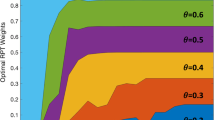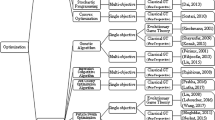Abstract
Ensuring truthfulness amongst self-interested agents bidding against one another in an auction can be computationally expensive when prices are determined using the Vickrey–Clarke–Groves (VCG) mechanism. This mechanism guarantees that each agent's dominant strategy is to tell the truth, but it requires solving n+ 1 optimization problems when the overall optimal solution involves n agents. This paper first examines a case-study example demonstrating how Operations Research techniques can be used to compute Vickrey prices efficiently. In particular, the case-study focuses on the Assignment Problem. We show how, in this case, Vickrey prices can be computed in the same asymptotic time complexity as that of the original optimization problem. This case-study can be seen as serving a pedagogical role in the paper illustrating how Operations Research techniques can be used for fast Vickrey pricing. We then propose a Constraint Programming approach that can be used in a more general context, where nothing is assumed about the nature of the constraints that must be satisfied or the structure of the underlying problem. In particular, we demonstrate how nogood learning can be used to improve the efficiency of constraint-based Vickrey pricing in combinatorial auctions.
Similar content being viewed by others
References
Bikhchandani, S., de Vries, S., Schummer, J. & Vohra, R. (2002). Linear Programming and Vickrey Auctions. In Mathematics of the Internet: E-Auction and Markets, 75–115.
Caseau, Y. & Laburthe, F. (1997). Solving Various Weighted Matching Problems with Constraints. In Principles and Practice of Constraint Programming, 17–31.
Dago, P. & Verfaillie, G. (1996). Nogood Recording for Valued Constraint Satisfaction Problems. In Proceedings of the 8th International Conference on Tools with Artificial Intelligence ÔICTAI '96Þ, 132–139.
Dechter, R. (1990). Enhancement schemes for constraint processing: Backjumping, learning and cutset decomposition. Artificial Intelligence 41(2): 273–312.
Dechter, R. (2003). Constraint Processing. Morgan Kaufmann.
Dijkstra, E. W. (1959). A note on two problems in connexion with graphs. Numerische Mathematik 1: 269–271.
Edmonds, J. & Karp, R. M. (1972). Theoretical Improvements in algorithmic efficiency for network flow problems. Journal of the Association of Computing Machinery 19(2): 248–264.
Focacci, F., Lodi, A. & Milano, M. (1999). Integration of CP and OR methods for matching problems. In CP-AI-OR'99 Workshop on Integration of AI and OR techniques in Constraint Programming for Combinatorial Optimization Problems.
Foster, I. (2001). The Anatomy of the Grid: Enabling Scalable Virtual Organizations. Lecture Notes in Computer Science 2150.
Fredman, M. L. & Tarjan, R. E. (1984). Network flow and testing graph connectivity. In 25th FOCS, 338–346.
Gondran, M. & Minoux, M. (1984). Graphs et Algorithmes. Wiley, English edition. Translated by Steven Vajda.
Hershberger, J. & Suri, S. (2001). Vickrey Pricing in Network Routing: Fast Payment Computation. In Proceedings of the 42nd IEEE Symposium on Foundations of Computer Science, 252–259.
Hung, C.-N., Hsu, L.-H. & Sung, T.-Y. (1993). The Most Vital Edges in a Bipartite Graph. Networks 23(4): 309–313.
Knuth, D. E. (1993). The Stanford GraphBase. Addison Wesley.
Kuhn, H. W. (1955). The Hungarian Method for the Assignment Problem. Naval Research Quarterly 2: 83.
Kumar, V. (1992). Algorithms for constraint-satisfaction problems: A survey. AI Magazine 13(1): 32–44.
Leyton-Brown, K. Pearson, M. & Shoham, M. (2000). Towards a universal test suite for combinatorial auction algorithms. In ACM Conference on Electronic Commerce, 66–76.
Mas-Collel, A., Whinston, M. D. & Green, J. R. (1995). Microeconomic Theory. Oxford University Press.
Nisan, N. & Ronen, A. (1999). Algorithmic Mechanism Design. In Proceedings of the 31st Annual ACM Symposium on Theory Computing.
Nisan, N. & Ronen, A. (2000). Computationally feasible VCG mechanisms. In ACM Conference on Electronic Commerce, 242–252.
Papdimitriou, C. H. & Steiglitz, K. (1982). Combinatorial Optimisation. Prentice-Hall.
Parkes, D. C. (2001). Iterative Combinatorial Auctions: Achieving Economic and Computational Efficiency. Ph.D. Thesis, Department of Computer and Information Science, University of Pennsylvania, May 2001.
Ratian, A. S., Denley, T. M. & Haggkvist, R. (1998). Bipartite Graphs and their Applications. Cambridge University Press.
Sandholm, T. (2002). Algorithm for Optimal Winner Determination in Combinatorial Auctions. Artificial Intelligence 135(1-2): 1–54.
Schiex, T. & Verfaillie, G. (1994). Nogood Recording for Static and Dynamic Constraint Satisfaction Problem. International Journal on Artificial Intelligence Tools (IJAIT) 3(2): 187–207.
Vickrey, W. (1961). Counterspeculation, auctions, and competitive sealed tenders. Journal of Finance: 8–37.
Walsh, W. Wellman, M. & Ygge, F. (2000). Combinatorial Auctions for Supply Chain Formulation. ACM Conference on Electronic Commerce.
Rights and permissions
About this article
Cite this article
Holland, A., O'sullivan, B. Towards Fast Vickrey Pricing using Constraint Programming. Artificial Intelligence Review 21, 335–352 (2004). https://doi.org/10.1023/B:AIRE.0000036262.43475.22
Issue Date:
DOI: https://doi.org/10.1023/B:AIRE.0000036262.43475.22




